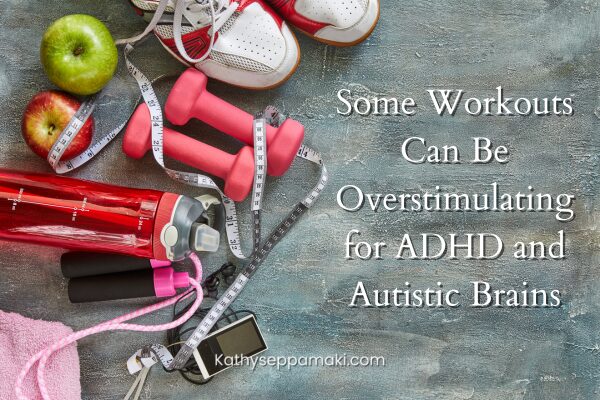We’re constantly told that in order to be healthy, we need to work out regularly. And yet some workouts may not be right for those with ADHD and autism. If you’ve ever started a new exercise routine with the best intentions, only to feel anxious, irritated, or completely drained afterward, you’re not alone. For neurodivergent folks with ADHD or autism, some forms of exercise can actually increase overstimulation instead of helping to relieve it.
While movement can be incredibly supportive for mental health and nervous system regulation, not every workout is a good fit for a sensitive or easily overloaded brain. Let’s explore why that happens and how to find movement that truly supports your body and mind.
Why some workouts feel overstimulating
Too much sensory input
Many gyms and fitness studios are a sensory nightmare…bright lights, loud music, people grunting, and machines clanging. Add in the smell of sweat and the press of bodies, and it’s easy to hit sensory overload fast. For autistic and ADHD individuals, this constant sensory barrage can make it nearly impossible to focus or feel safe.
High-intensity workouts spike stress hormones
HIIT, boot camps, or competitive sports can overstimulate the nervous system. Instead of providing the dopamine boost many ADHD brains crave, they can actually flood the body with cortisol and adrenaline, leaving you feeling shaky or emotionally fried afterward.
Difficulty with transitions and routines
Executive dysfunction can make it hard to get to a gym class on time, remember your gear, or manage a multi-step routine. The pressure of following instructions quickly or coordinating complex movements can feel overwhelming, especially if you’re masking or self-conscious.
Too much social energy
Group classes or team sports often require small talk, reading social cues, and managing interpersonal dynamics—all of which can be exhausting for neurodivergent people who need to conserve energy for other parts of their day.
What to try instead
Finding movement that regulates rather than overstimulates is all about matching your nervous system’s needs.
1. Slow, rhythmic movement
Activities like walking, swimming, dancing alone in your kitchen, or gentle yoga can be grounding. The repetitive, rhythmic nature of these movements soothes the nervous system and helps regulate sensory input.
2. Nature-based exercise
Moving outdoors—whether it’s hiking, gardening, or beach walks—can provide calming sensory input from natural sounds, fresh air, and organic light. Nature tends to balance overstimulated systems beautifully.
3. Solo or low-pressure activities
Try things you can do alone, at home, or without judgment—like stretching, rebounding on a mini trampoline, or following along with a low-key YouTube workout. The freedom to pause or modify as needed can make movement far more accessible.
4. Mind-body connection practices
Tai chi, qi gong, or slow yoga flows encourage awareness and calm. They help you reconnect with your body’s signals instead of pushing through discomfort or ignoring sensory cues.
5. Movement as regulation, not punishment
Shift the mindset from “I should work out” to “What movement would help my body feel safe and supported right now?” Sometimes, the best exercise is a short dance break, a walk in the sun, or stretching before bed.
Final Thoughts
For ADHD and autistic individuals, movement should feel nourishing, not draining. You don’t have to force yourself into neurotypical fitness molds that leave you frazzled. The right kind of movement helps regulate your nervous system, improve focus, and deepen your connection to your body.
So if traditional workouts make you feel overwhelmed, it’s not that you’re lazy or unmotivated; you’re just tuned into what your body actually needs. And that’s something worth celebrating.

